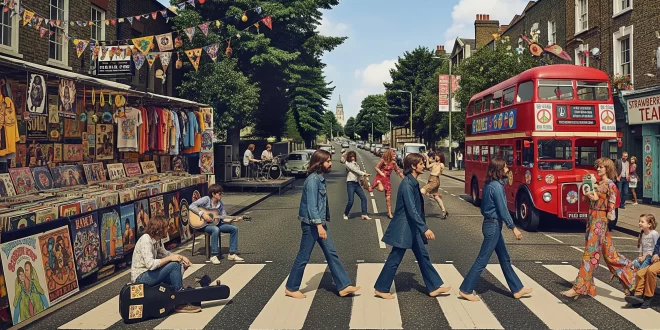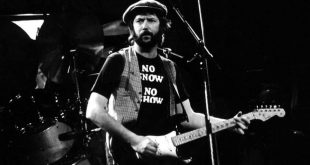At first glance, Abbey Road might look like any ordinary crosswalk in North West London. But to millions around the world, it’s a sacred site in music history. Immortalized by the Beatles’ final studio album cover in 1969, Abbey Road has transcended its geographic location and become a symbol of creativity, transformation, and lasting cultural impact.
In this article, we’ll explore why Abbey Road is more than just a crosswalk. From the stories behind the famous album cover to its lasting legacy in pop culture, we’ll dive into what makes this simple zebra crossing a global pilgrimage site for music lovers.
1. The Album That Changed Everything
When The Beatles released Abbey Road in 1969, they were already the most famous band on the planet. But the album marked a final creative peak before their breakup.
Key highlights:
- It featured timeless tracks like “Come Together,” “Something,” and the medley on Side B, which many critics call their most ambitious piece of music.
- George Harrison emerged as a songwriting powerhouse with “Here Comes the Sun” and “Something”.
- The album showcased musical unity even as the band was breaking apart.
📝 Legacy: Abbey Road became a symbol of excellence, a farewell masterpiece that still influences musicians today.
2. The Crosswalk Photo: Simplicity Turned Iconic
The album cover is perhaps the most recognizable in music history. Taken outside EMI Studios (later renamed Abbey Road Studios), the image shows the four Beatles walking across the street in single file.
There’s no album title, no band name. Just confidence. Just The Beatles.
📸 Shot Facts:
- Photographer: Iain Macmillan
- Only 6 photos were taken
- The winning shot was frame #5
🎨 Why it matters: The photo captures a moment in time—minimalist, symbolic, rebellious. It’s been parodied, re-created, and memed countless times.
3. Fan Pilgrimage: A Living Monument
Today, Abbey Road isn’t just a road—it’s a destination. Each year, thousands of fans:
- Walk the crosswalk
- Take Beatles-inspired photos
- Leave messages on the studio wall
- Share their experiences online
🌍 The spot is even marked on Google Street View, and there’s a 24/7 live webcam where fans around the world can watch the crossing in real time.
4. Myths and Mysteries: The Paul Is Dead Theory
One of the most enduring conspiracies surrounding the Abbey Road cover is the “Paul is dead” theory. Fans believed that:
- Paul McCartney had died in a car crash in 1966
- The cover symbolized a funeral procession:
- John: preacher (white)
- Ringo: undertaker (black)
- Paul: corpse (barefoot and out of step)
- George: gravedigger (denim)
🧠 While debunked, the myth added a layer of intrigue and mystery that made Abbey Road even more legendary.
5. Abbey Road Studios: The Soundtrack of Generations
Abbey Road isn’t just the site of an iconic photo—it’s home to one of the most famous recording studios in the world.
Artists who’ve recorded here include:
- Pink Floyd (The Dark Side of the Moon)
- Oasis
- Adele
- Radiohead
- Lady Gaga
- And of course, The Beatles, who recorded 190+ songs there
🎶 The studio has become synonymous with high-fidelity, artistic excellence, and timeless production.
6. Symbolism and Cultural Impact
Abbey Road symbolizes far more than a band or a photo.
It represents:
- Endings and new beginnings
- Creative brilliance in the face of tension
- Unity through music
- The power of place in storytelling
💡 Many consider it a physical manifestation of musical pilgrimage, much like Graceland for Elvis fans.
7. Pop Culture Legacy
Abbey Road’s zebra crossing has been:
- Recreated by The Simpsons, Kanye West, U2, and Sesame Street
- Featured in films, commercials, music videos, and TV shows
- Incorporated into street art and fashion
Even modern artists acknowledge Abbey Road as the gold standard for artistic transition and cultural imprinting.
8. A Global Landmark, Not Just a London One
In 2010, the British government granted Abbey Road zebra crossing protected status, recognizing it as a cultural and historical site.
🏛 It’s the only crosswalk in the world to receive such treatment.
And while it’s just 22 feet long, Abbey Road represents something much bigger: the global power of music to unite, inspire, and transform.
Conclusion: Abbey Road Is a Symbol, Not Just a Street
Abbey Road may appear to be an ordinary stretch of pavement—but it carries the weight of decades of musical genius, myth-making, and fan devotion.
It’s where a band walked away from each other—and into history.
Today, Abbey Road is more than a crosswalk. It’s a living canvas of human creativity, where music meets memory, and the past continues to walk alongside us—four steps at a time.
Suggested Posts
- 🎸 The Hidden Meanings Behind Beatles Lyrics
- 📀 How The Beatles Influenced Today’s Pop Stars
- 🧭 The Beatles vs. The Rolling Stones: Who Ruled the 60s?
FAQs
Q: Where is Abbey Road located?
A: Abbey Road is in the St. John’s Wood area of London, near the Abbey Road Studios where The Beatles recorded.
Q: Can you walk on the Abbey Road crosswalk?
A: Yes! It’s a functioning pedestrian crossing and a popular tourist attraction.
Q: Is Abbey Road Studios open to the public?
A: Not typically, though occasional tours and events are offered. The studio has a gift shop and an online experience for fans.







One comment
Pingback: How Fleetwood Mac Inspired The Beatles’ Overlooked Song ‘Sun King’ - The Beatles